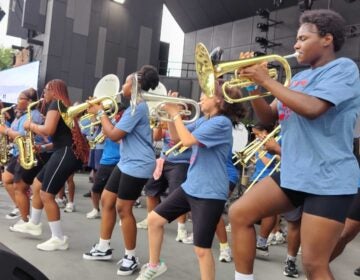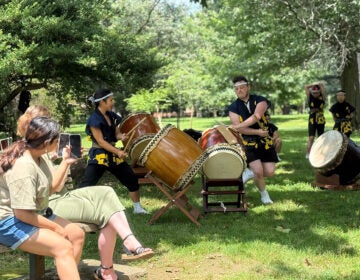Castle Valley Mill, A Tour of Abolitionism in Philadelphia, Atlas Obscura at Mount Moriah
Castle Valley Mill
Producer: Monica Rogozinski
Nestled on the banks of Neshaminy Creek in historic Bucks County, Pennsylvania, Castle Valley Mill began grinding Bucks County grains in 1730. Built on land that was given to the Meredith family by William Penn, the mill has been known as Grove’s Mill, Reed’s Mill, and now Castle Valley Mill. This historic building has witnessed the birth, growth and advance of our country. With the Industrial Revolution came internal combustion engines and electricity, and slowly, the value of water power diminished, and the buildings fell into disrepair. The property was in poor condition when Mark Fischer’s grandfather, Henry Fischer, purchased and restored the property in 1947. A miller from Erlbach, Germany, Henry loved the honest hard work and satisfaction of milling and made Castle Valley his home. His hobby was the on-going repair as restoration of the mill and the milling machinery – a quest that Mark continues to this day. Henry saved many milling machines and examples of American technology and ingenuity when older mills in Bucks County were being torn down or gutted. From this collection Castle Valley Mill has restored several antique stone mills and processing machines and have put them back in operation.
Friday Arts meets with Fran and Mark Fisher and tours the mill to learn the process of stone ground milling and the result in quality gained from producing the finest flours, meals, cleaned whole berry grains, and grain mixes. The grains are processed slowly and at cool temperatures on antique buhr mills, the flavor, nutrients, and wholesome goodness of the grain is preserved, and produces exceptional quality foods. The result has proved its difference in quality and taste by the hands of acclaimed pastry chefs in our region such as Alex Bois from High Street on Market and Claire Kopp McWilliams from Restaurant Vetri.
Mark and Fran explain how a single piece of grain is the most nutritiously dense food you can eat, and the same amount of commercial white flour is the least nutritiously dense food you can eat. Mark correlates the industrial processing of flour in order to make it shelve stable, with the increase in gluten intolerance and celiac disease that has been on the rise in our community. ” We produce a healthy, quality product that is food the way God meant it to be: Natural, healthy, nutritious, and full of flavor”. (Mark Fisher)
A Tour of Abolitionism in Philadelphia
Producer: Karen Smyles
The City of Philadelphia played an important role in the effort to abolish slavery. The Society for the Relief of Free Negroes Unlawfully Held in Bondage was the first American abolition society and was founded by the Quakers here on April 14, 1775. In 1784 it was reorganized as the Pennsylvania Society for Promoting the Abolition of Slavery and for the Relief of Free Negroes Unlawfully Held in Bondage (better known as the Pennsylvania Abolition Society).
In June of this year WHYY offered members a tour of several African American historical sites here in Philadelphia. The sold out event began at the historical marker just outside our building, that marks the location of Pennsylvania Hall.
Built in the late 19th century, Pennsylvania Hall was the meeting place for abolitionists, but was built at a time when there was a growing anti-abolition sentiment. For 3 days it lived up to expectations drawing people of various backgrounds and races. However, the night of May 17th, 1838 anti-black rioters burned the building to the ground. When the volunteer fire departments were called, they were strictly ordered not to fight the fire. The buildings ruins were left on exhibit for a couple of years to remind abolitionists that not everyone welcomed them.
The tour was lead by archaeologist, Doug Mooney, and Justina Barrett, site manager for Fairmount Park’s historic houses. After the Pennsylvania Hall stop, it travelled on to Belmont Mansion and Strawberry Mansion, where Friday Arts spoke with Connie Ragsdale, board president. Ragsdale gave us the history and a tour of the home. Strawberry Mansion was built by Judge William Lewis, author of the Gradual Abolition Act.
Our last stop was 6th & Market where the Presidents House once stood, now home of the Liberty Bell Pavillion. The home was once occupied by Presidents Washington and Adams.
Mooney shared with tour members the history of the slaves who lived there with Washington and the story behind the decision to leave an excavated portion of the site on exhibit.
Atlas Obscura at Mount Moriah
Producer: Michael O’Reilly
In an age where everything seems to have been explored and there is nothing new to be found, Atlas Obscura celebrates a different way of looking at the world. If you’re searching for miniature cities, glass flowers, books bound in human skin, gigantic flaming holes in the ground, bone churches, balancing pagodas, or homes built entirely out of paper, Atlas Obscura is where you’ll find them.
Atlas Obscura (AO) is a book and website and an event-holding organization but at its heart it is a collaborative project. A community of explorers helps to discover amazing places and share them with the world. Anyone, anywhere in the world can add a place to the Atlas.
Dylan Thurus, one of the co-founders of AO, tells about just such an event – a tour of Mt. Moriah cemetery – a cemetery largely left to its own devices for the past few decades in Southwest Philadelphia. Relatively unknown to most of the population of Philadelphia, Mt Moriah still stands after 161 years. It turns out, events and tours like the one put on by Atlas Obscura, are helping to stabilize the cemetery, by generating revenue, interest and volunteers.
WHYY is your source for fact-based, in-depth journalism and information. As a nonprofit organization, we rely on financial support from readers like you. Please give today.




